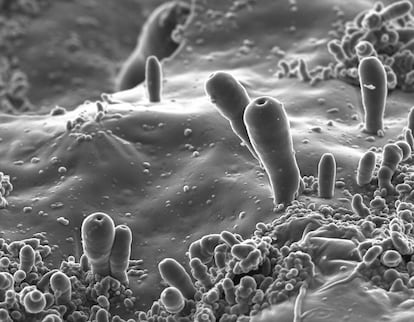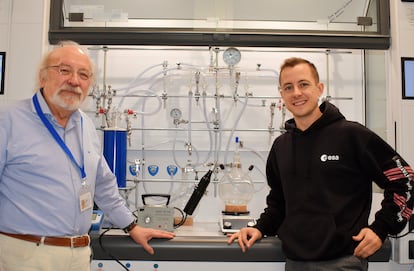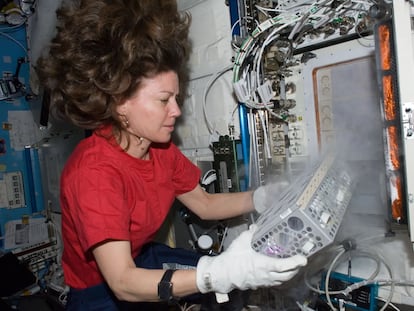Protocells emerge in experiment simulating lifeless world: ‘There is no divine breath of life’
Researchers from a Spanish laboratory observe, for the first time, the formation of compartments alongside the basic ingredients of organisms

Geologist Juan Manuel García Ruiz still speaks with amazement about how he and his colleagues have created “a proto-world” in their laboratory, located just 1,500 meters from La Concha beach in the Spanish city of San Sebastián. It may sound monumental, and it is, but what they have is a small, transparent container, just three liters in size, where they’ve placed a mixture of water, methane, nitrogen, and ammonia, adding electric discharges to simulate the harsh conditions of the primitive Earth. This experiment is a new iteration of the famous 1952 work by Stanley Miller, a 22-year-old American chemist who demonstrated that the basic building blocks of life could be easily created in a primordial soup. García Ruiz, however, has encountered an unexpected development. “Protocells” have also formed in his flask — structures considered to be the precursor to life itself. “It is amazing,” he declares.
The 71-year-old Spanish researcher explains that his experiment lasted barely two weeks. Almost immediately, a thin layer formed on the surface, much like cream on milk, and the once-clear water turned a yellowish brown. The microscope images are perplexing, revealing a multitude of tiny, curvilinear structures that any observer might mistake for living organisms — yet they are not. They are simply self-organized molecules.
“We have always approached the origin of life following the biblical text, as though there were a divine breath, a singular moment where everything becomes irreversible. What our study suggests is that it wasn’t like that, but that it is a chemical evolution of millions of years, absolutely random, like subsequent biological evolution, and that it increases in complexity over time. It can lead to self-organized structures and, in some cases, to self-assembled structures, like life,” García Ruiz explains. “These types of proto-worlds must exist on billions of planets throughout the universe. And these proto-worlds may lead to something as complex as life, or to nothing at all. There’s no intelligent design, no divine breath of life, and no fundamental reaction either,” says García Ruiz, a geologist from the Donostia International Physics Center.
In February 1953, a twenty-something Stanley Miller wrote up his groundbreaking results in just a dozen paragraphs and changed the way humanity saw itself. He demonstrated that with three gases, water, and electric discharges, it was possible to create amino acids in a laboratory — molecules that form proteins, the biological machines that constitute living matter.
Juan Manuel García Ruiz’s team replicated Miller’s experiment in 2021, but instead of using the original glass container, they opted for one made of Teflon. Their conclusion made headlines around the world: no building blocks of life emerged in their experiment. Silica — a mineral composed of silicon and oxygen, found in glass — was essential. Last year, a consortium led by García Ruiz received €10 million ($10.4 million) from the European Union to investigate the role of silica in the origin of life.
The new experiment not only generated amino acids but also the five nucleobases that form the core of DNA. However, the most significant breakthrough was the simultaneous appearance of “protocells.” García Ruiz explains that these protocells are hollow vesicles that compartmentalize space, encapsulating the building blocks of life and facilitating their reactions with one another — an essential step in the primordial soup of early Earth. “These protocells must have also appeared in Miller’s experiment and in subsequent ones, but no one had looked for them until now,” says García Ruiz, who led the research with his German colleague Christian Jenewein.

Their findings suggest that life on Earth could have originated hundreds of millions of years earlier than previously believed, potentially during the Hadean period — the geological era that began 4.6 billion years ago with Earth’s formation and ended around 4 billion years ago. García Ruiz notes that their “protocells” form through the action of bubbling, using repeated units of hydrocyanic acid, a simple molecule composed of one hydrogen atom, one carbon atom, and one nitrogen atom. “Several studies suggest that these polymers of hydrocyanic acid could lead to everything needed to create the basic building blocks of life,” the geologist explains. His study was published Monday in PNAS, the journal of the U.S. National Academy of Sciences.
Mexican biologist Antonio Lazcano recalls that 100 years ago, Soviet scientist Aleksandr Oparin published The Origin of Life, in which he defended the hypothesis that the first organisms arose from the chemical evolution of molecules in the primordial soup of early Earth. Amid the Cold War, a young Stanley Miller built on Oparin’s work. “The merit of García Ruiz’s study is in following the evolution of simple molecules to the formation of complex microscopic structures within a single system,” applauds Lazcano, founder of the Laboratory of the Origin of Life at Mexico’s National Autonomous University (UNAM).
However, Lazcano remains cautious. “I would not call them protocells, because that suggests an evolutionary continuity that is far from being demonstrated, and that does not correspond to their chemical composition,” he notes. “They are right to write that they may have been microreactors that allowed other reactions, but we are still far from constructing a detailed and realistic sequence of evolution that led from the inorganic components and molecules of the prebiotic Earth to the first organisms, among other reasons because we still do not agree on what would be a good definition of ‘first forms of life.’”
García Ruiz himself emphasizes this uncertainty. “I would say that the conclusion of our work is that, today, the difference between the living and the non-living is less clear than ever, both morphologically and chemically,” says the geologist, who is also an emeritus researcher at the Andalusian Institute of Earth Sciences (CSIC) in Granada, where part of the experiments were conducted. He cautions that space missions, which will soon bring back rocks from Mars, could potentially reveal amino acids, DNA nucleobases, and even these “protocells,” but that would not necessarily prove the existence of extraterrestrial life.
Kepa Ruiz Mirazo, a philosopher of biology and expert in the origin of life and protocellular models, also applauds García Ruiz’s “excellent work.” “The significance of this research, beyond placing the first steps toward life in very remote times, lies in the fact that the synthesis of organic molecules in the style of Miller’s experiment is now accompanied by the formation of compartments with a size, morphology, and topology similar to those of a cell,” notes Ruiz Mirazo, from the University of the Basque Country.
“It remains to be seen — and I hope this group will take on the challenge of proving it — whether these types of closed and hollow supramolecular structures could be coupled with prebiotic chemistry, with which to co-evolve towards truly protocellular forms of organization, establishing mechanisms for the exchange of matter and energy with their environment,” says Ruiz Mirazo. “From my perspective, the encapsulation of biomolecular precursors, although necessary (as the authors of the article argue), is not in itself a sufficient condition for a compartment to be considered a protocell. However, this is how science advances in all fields: the more significant an achievement, the more questions it raises. Continuing research in this area will undoubtedly broaden horizons in the search for our deepest and most distant origins, as the biological entities we are.”
Geologist García Ruiz is preparing an expedition to Kenya in 2026, to the Rift Valley, an area he believes bears similarities to the early Earth, with alkaline lakes and abundant silica. In the meantime, his team will continue experimenting with Miller’s classic approach, exploring new variations — changing the temperature and adding ingredients like sulfur, phosphorus, and carbon monoxide. “We are going to extend the time and start cooking, to see what happens,” he says.
Sign up for our weekly newsletter to get more English-language news coverage from EL PAÍS USA Edition
Tu suscripción se está usando en otro dispositivo
¿Quieres añadir otro usuario a tu suscripción?
Si continúas leyendo en este dispositivo, no se podrá leer en el otro.
FlechaTu suscripción se está usando en otro dispositivo y solo puedes acceder a EL PAÍS desde un dispositivo a la vez.
Si quieres compartir tu cuenta, cambia tu suscripción a la modalidad Premium, así podrás añadir otro usuario. Cada uno accederá con su propia cuenta de email, lo que os permitirá personalizar vuestra experiencia en EL PAÍS.
¿Tienes una suscripción de empresa? Accede aquí para contratar más cuentas.
En el caso de no saber quién está usando tu cuenta, te recomendamos cambiar tu contraseña aquí.
Si decides continuar compartiendo tu cuenta, este mensaje se mostrará en tu dispositivo y en el de la otra persona que está usando tu cuenta de forma indefinida, afectando a tu experiencia de lectura. Puedes consultar aquí los términos y condiciones de la suscripción digital.
More information
Archived In
Últimas noticias
The murder of Michele and Rob Reiner: A tale of horrific days in Hollywood
Trump orders a ‘complete blockade of sanctioned oil tankers’ going to and from Venezuela
Not all insomnia is the same: Study identifies five subtypes and paves the way for personalized treatment
The United States designates Clan del Golfo as a foreign terrorist group
Most viewed
- ‘El Limones’ and the growing union disguise of Mexican organized crime
- Christian Louboutin: ‘Young people don’t want to be like their parents. And if their parents wear sneakers, they’re going to look for something else’
- ‘We are dying’: Cuba sinks into a health crisis amid medicine shortages and misdiagnosis
- A mountaineer, accused of manslaughter for the death of his partner during a climb: He silenced his phone and refused a helicopter rescue
- The low-cost creative revolution: How technology is making art accessible to everyone











































